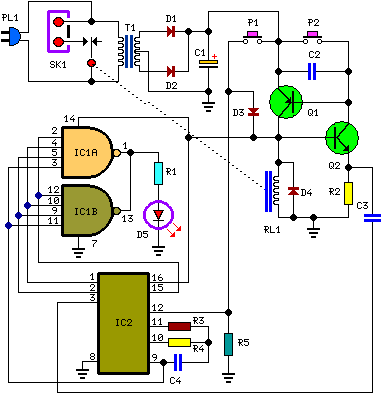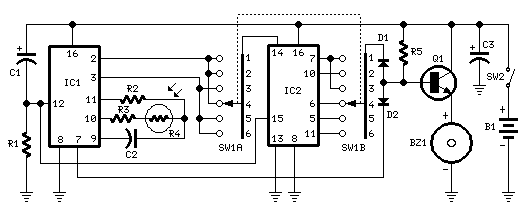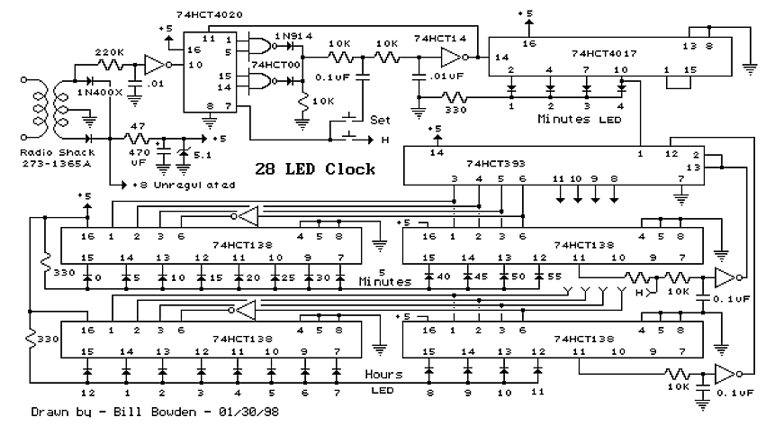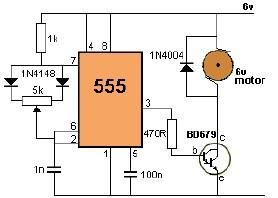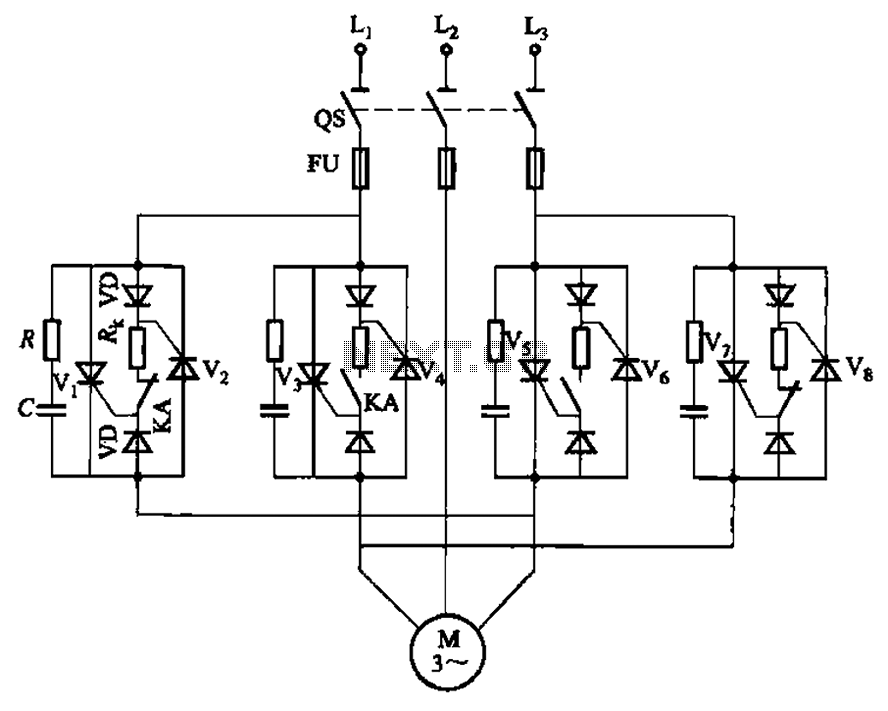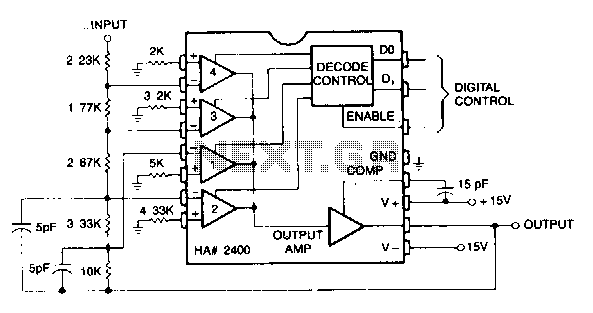
Microprocessor programmable interval timer
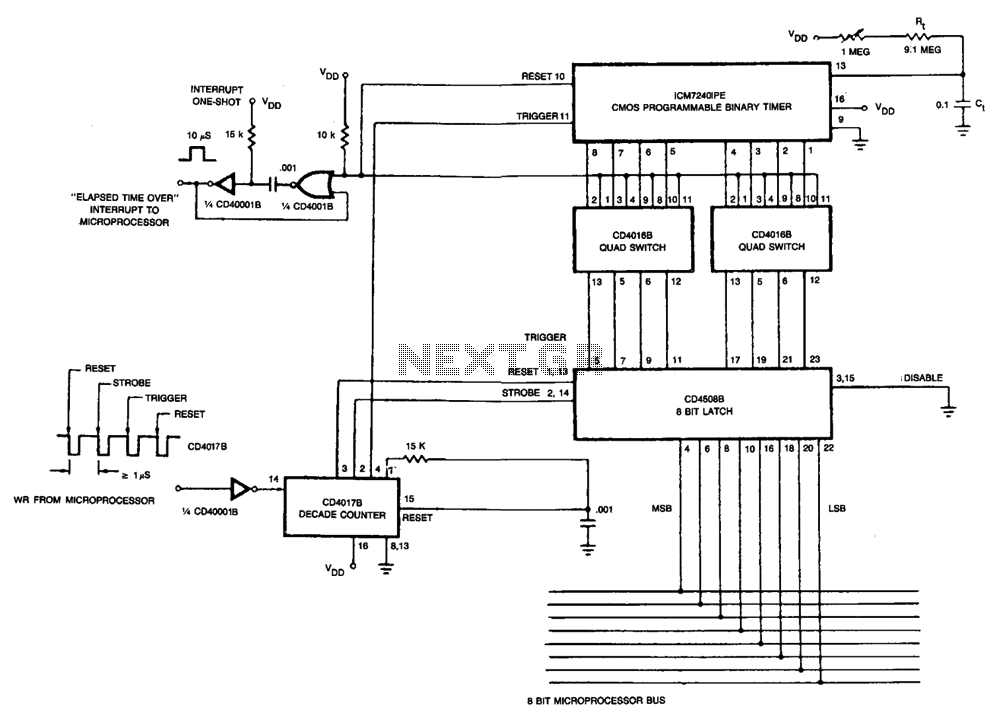
The microprocessor transmits an 8-bit binary code through its 8-bit I/O bus, which is necessary for programming the ICM7240. This is followed by four WRITE pulses directed to the CD4017B decade counter. The first pulse resets the 8-bit latch, the second pulse loads the binary value into the latch, the third pulse initiates the timing cycle of the ICM7240, and the fourth pulse resets the decade counter. The ICM7240 then measures the time interval based on the R-C value connected to pin 13 and the binary count set on pins 1 through 8.
At the conclusion of the programmed time interval, an interrupt one-shot is activated, signaling the microprocessor that the designated time has elapsed. By utilizing a resistor of approximately 10 ohms and a capacitor of 0.1 µF, the ICM7240 establishes a time base of one second. Consequently, the microprocessor can program time intervals ranging from 1 to 255 seconds, with the ability to adjust either R or C to select longer or shorter time bases.
The described circuit utilizes a microprocessor to control an ICM7240 timer, interfacing through an 8-bit I/O bus. The microprocessor sends an 8-bit binary code that configures the timer, which is essential for timing applications. The CD4017B decade counter is employed to manage the timing operations through a series of WRITE pulses. The first pulse is crucial for resetting the 8-bit latch, ensuring that any previously stored data does not interfere with new inputs. The second pulse is responsible for transferring the binary code into the latch, effectively programming the timer with the desired count.
The third pulse is significant as it triggers the ICM7240 to commence its timing cycle, initiating the measurement of the time interval based on the external resistor-capacitor (R-C) configuration connected to pin 13. This configuration determines the duration of the timing cycle, which can be adjusted to meet specific application requirements. The fourth pulse resets the CD4017B counter, preparing it for subsequent operations.
Once the programmed time interval elapses, the interrupt one-shot is activated, which serves as a notification mechanism to the microprocessor, indicating that the timing cycle has completed. This feature allows the microprocessor to undertake further actions based on the elapsed time.
The choice of a 10-ohm resistor and a 0.1 µF capacitor establishes a one-second time base for the ICM7240. This configuration allows for programming time intervals that can be varied from 1 to 255 seconds, providing flexibility in timing applications. Adjustments to the R or C values enable the selection of different time bases, facilitating a wide range of timing scenarios suitable for various electronic applications.The microprocessor sends out an 8-bit binary code on its 8-bit I/O bus (the binary value needed to program the ICM7240), followed by four WRITE pulses into the CD4017B decade counter. The first pulse resets the 8-bit latch, the second strobes the binary value into the 8-bit latch, the third triggers the ICM7240 to begin its timing cycle and the fourth resets the decade counter.
The ICM7240 then counts the interval of time determined by the R-C value on pin 13, and the programmed binary count on pins 1 through 8. At the end of the programmed time interval, the interrupt one-shot is triggered, informing the microprocessor that the programmed time interval is over. With a resistor of approximately 10 ohm and a can capacitor of 0.1 µ¥, the time base of the ICM7240 is one second.
Thus, a time of 1-255 seconds can be programmed by the microprocessor, and by varying R or C, longer or shorter time bases can be selected. 🔗 External reference
At the conclusion of the programmed time interval, an interrupt one-shot is activated, signaling the microprocessor that the designated time has elapsed. By utilizing a resistor of approximately 10 ohms and a capacitor of 0.1 µF, the ICM7240 establishes a time base of one second. Consequently, the microprocessor can program time intervals ranging from 1 to 255 seconds, with the ability to adjust either R or C to select longer or shorter time bases.
The described circuit utilizes a microprocessor to control an ICM7240 timer, interfacing through an 8-bit I/O bus. The microprocessor sends an 8-bit binary code that configures the timer, which is essential for timing applications. The CD4017B decade counter is employed to manage the timing operations through a series of WRITE pulses. The first pulse is crucial for resetting the 8-bit latch, ensuring that any previously stored data does not interfere with new inputs. The second pulse is responsible for transferring the binary code into the latch, effectively programming the timer with the desired count.
The third pulse is significant as it triggers the ICM7240 to commence its timing cycle, initiating the measurement of the time interval based on the external resistor-capacitor (R-C) configuration connected to pin 13. This configuration determines the duration of the timing cycle, which can be adjusted to meet specific application requirements. The fourth pulse resets the CD4017B counter, preparing it for subsequent operations.
Once the programmed time interval elapses, the interrupt one-shot is activated, which serves as a notification mechanism to the microprocessor, indicating that the timing cycle has completed. This feature allows the microprocessor to undertake further actions based on the elapsed time.
The choice of a 10-ohm resistor and a 0.1 µF capacitor establishes a one-second time base for the ICM7240. This configuration allows for programming time intervals that can be varied from 1 to 255 seconds, providing flexibility in timing applications. Adjustments to the R or C values enable the selection of different time bases, facilitating a wide range of timing scenarios suitable for various electronic applications.The microprocessor sends out an 8-bit binary code on its 8-bit I/O bus (the binary value needed to program the ICM7240), followed by four WRITE pulses into the CD4017B decade counter. The first pulse resets the 8-bit latch, the second strobes the binary value into the 8-bit latch, the third triggers the ICM7240 to begin its timing cycle and the fourth resets the decade counter.
The ICM7240 then counts the interval of time determined by the R-C value on pin 13, and the programmed binary count on pins 1 through 8. At the end of the programmed time interval, the interrupt one-shot is triggered, informing the microprocessor that the programmed time interval is over. With a resistor of approximately 10 ohm and a can capacitor of 0.1 µ¥, the time base of the ICM7240 is one second.
Thus, a time of 1-255 seconds can be programmed by the microprocessor, and by varying R or C, longer or shorter time bases can be selected. 🔗 External reference
